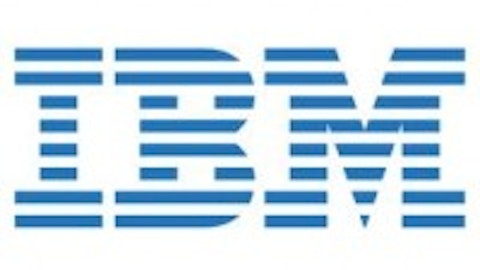This was one tech giant investors had a lot of hope from. Sadly, its recently announced numbers didn’t live up to expectations. What does that say about the stock’s future? Well, let’s see..

Oracle Corporation (NASDAQ:ORCL) announced lackluster results for the third quarter of 2013. Following the earnings release, the company’s share tumbled nearly 10%. Let’s see what happened.
That don’t impress me much
Total revenue fell 1% from last year to $9 billion. The major reason was quoted as poor sales execution. The slip was mainly due to a 4% fall in revenue from software, which contributes to approximately 74% of the total revenue. Revenue from new software license sales, along with cloud-based subscriptions, decreased 2%.
Revenues from the two segments went down to $2.3 billion for the quarter. Further, revenue from hardware also contracted 16% year on year, mainly due to weak performance by Oracle’s M Series servers.
However, Oracle’s GAAP earnings per share are up from $0.49 in the same quarter last year to $0.52 this quarter. There has been no percentage change in net income from the same quarter last year, while operating income is up 1%.
It is to be noted that had there been no strengthening of the U.S. Dollar against foreign currencies, there would have been no year on year change in Oracle Corporation (NASDAQ:ORCL)’s total revenues.
Tomorrow belongs to us
In the months to come, Oracle Corporation (NASDAQ:ORCL) plans to begin delivering new servers based on the SPARC T5 microprocessor, believed to be “the fastest microprocessor in the world.” Further, the M9 server line is soon to be replaced by an advanced M5 server. Imminent release of new products was also one of the reasons for the drop in hardware sales the last quarter, as customers postponed hardware system purchases.
To some extent, the poor sales results are also due to the European crisis, leading to a fall in demand. In fact, sale from hardware system products in Europe, Middle East & Africa declined nearly 24% as compared to the same period last year.
Slowin’ down
This wasn’t unexpected. Macroeconomic sluggishness has been a problem faced by most technology companies in recent times. Oracle Corporation (NASDAQ:ORCL)’s major competitor, International Business Machines Corp. (NYSE:IBM), also saw a similar decline in revenue from Europe, Middle East & Africa in the last quarter.
At $9.1 billion, IBM’s revenue from this region was down 5% year on year. However, IBM saw an 11% increase in revenue from Brazil, Russia, India, and China as compared to last year. This is in contrast to Oracle, which saw a decline in revenue in all geographic regions.
Times are a-changin’
The IT industry is currently going through a transition period, with more and more companies opting for cloud-based computing. Oracle, being a relative newcomer in the arena, is obviously facing tough competition from the likes of Amazon.com, Inc. (NASDAQ:AMZN), SAP AG (ADR) (NYSE:SAP), and salesforce.com, inc. (NYSE:CRM).
SAP AG (ADR) (NYSE:SAP), one of Oracle Corporation (NASDAQ:ORCL)’s biggest competitors, already has a huge market share in cloud computing, and aims to raise $2.6 billion in revenue from it by 2015. The company has recently launched ‘SAP 360 Customer’, which aims to combine various different technologies. Coupled with its database technology offering HANA, this will definitely boost its market share further. In fact, the company expects to see a rise of 14%-20% in revenue from cloud subscriptions for the full year 2013.
This could mean tougher times for Oracle, a company which is known for its high profit margins. In the face of tough competition, the company may be forced to offer its solutions at lower prices, in exchange for a greater market share.
Don’t you worry child..
Investors in Oracle do not have much to worry about, though. For one, Oracle Corporation (NASDAQ:ORCL) has plans to expand its cloud computing line in the coming quarters. It aims to align its high-tech hardware department with its software applications and databases, such that it becomes a one-stop shop for everything related to cloud computing.
Secondly, the company has a solid traditional customer base, most of whom are still loyal to the brand. Lastly, its new hardware offerings may finally bring about a turnaround in its declining hardware sales, given that they are all cutting edge. With revenue for the upcoming year poised to grow about 6%, a few acquisitions may be all it takes to rev up this tech giant.
The article Should You Hit the Panic Button on This Stock? originally appeared on Fool.com and is written by Sonam Chamaria.
Copyright © 1995 – 2013 The Motley Fool, LLC. All rights reserved. The Motley Fool has a disclosure policy.

